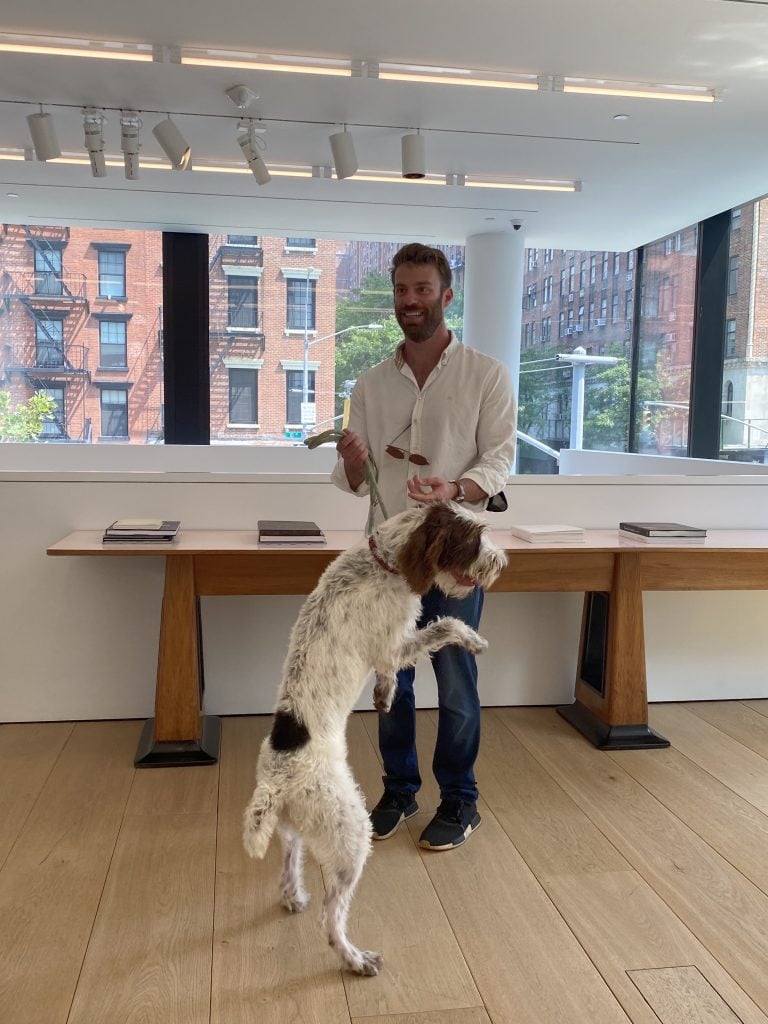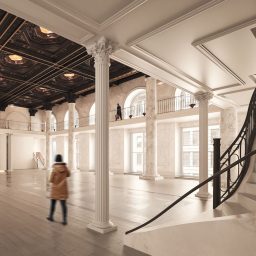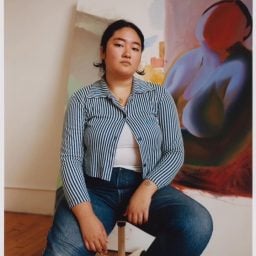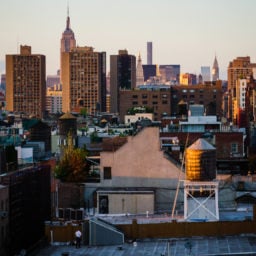For nearly a decade, the New York realtor Jonathan Travis has been working with galleries like Casey Kaplan, James Cohan, and Canada to help them find spaces suitable for their programs. In fact, the southern migration of New York dealers from Chelsea to the budding hub of Tribeca can be attributed partly to Travis, who foresaw in 2014 that Chelsea would undergo the kind of development that would likely push dealers out in search of greener pastures.
Travis, who’s now 35, has since delved deeper in, amassing an impressive collection of over 200 artworks with a strong focus on young figurative painters. He likes to buy directly from young artists, or from emerging galleries. This collecting strategy has allowed him to obtain works by budding stars such as Issy Wood, Tunji Adeniyi-Jones, and Julie Curtiss before their works hit unattainable prices.
Travis recently moved an hour north of New York City to Westchester County, buying a cavernous house with plenty of fresh wall space. There, he will soon open the Wolf Hill Residency, a nonprofit program giving young artists the opportunity to work in a distraction-free environment.
Prior to the opening of his residency, Travis sat down with Artnet News to talk about how a young commercial broker with no ties to the art world became the city’s go-to guy for gallery space.
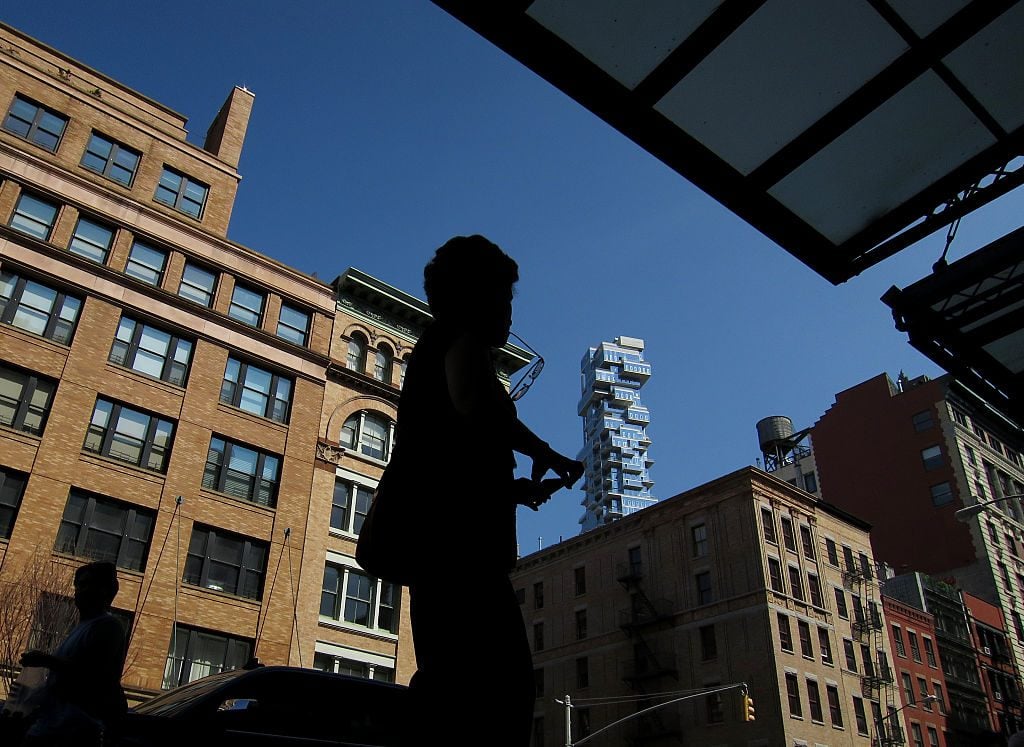
Tribeca on May 31, 2016 in New York City. (Photo by Gary Hershorn/Getty Images)
You got your start in the art world in 2014 with a cold email to Casey Kaplan about finding him a new space. Of all the businesses in New York in need of commercial real estate, you chose to reach out to an art gallery. Why?
I got my start working at Newmark Knight Frank, which is the corporate behemoth of the commercial real estate world, equivalent to Goldman Sachs or J.P. Morgan. The training there was invaluable and I learned a lot, but I also learned that was not the right environment for me. As a young broker, they tell you there’s a couple of ways to earn money. Either you can help senior brokers with their client accounts by doing mundane tasks like showing spaces and putting together presentation materials, or you can spend your time canvassing and figuring out how to bring in new business.
I felt that to make myself indispensable, I had to create my own clientele, so they can’t just decide they don’t like you anymore and fire you. But I didn’t want to do it in that environment. So after getting my training and learning the ropes in a very competitive and cutthroat environment, I went out on my own and decided to use the techniques they taught me to canvas for new business in my own way.
One day I was reading the Wall Street Journal and there was an article about what was going to happen in West Chelsea. This was in 2013 or maybe early 2014. The Hudson Yards project was coming in, you had the High Line exploding, the Meatpacking District became this big touristy retail destination, and the Whitney moved there. I recognized this was the last frontier in Manhattan for major development because a lot of the buildings that were still there were single-story autobody shops, or old industrial buildings. It wasn’t a landmark district for the most part, and it seemed there was going to be an opportunity to build a lot of new buildings there.
Casey Kaplan was quoted in the article saying something along the lines of, I see what’s happening to the neighborhood in the future, and I don’t like it, so I may want to leave my space. That was my opening.
Since he was the first prominent dealer to leave the neighborhood, the Real Deal, which is one of the two major real estate publications in New York, ran an article about it. It was great exposure, a combination of good timing, some luck, and some skill. After the article came out, a couple other dealers in the neighborhood reached out to me and said, “We’re also thinking about leaving West Chelsea. Can we talk?”

People walk along the High Line in Manhattan, New York city on May 19, 2021. (Photo by ED JONES/AFP via Getty Images)
Prior to that, did you have any contact with the art world at all?
My family appreciated art. We would go to museums when we traveled and we all enjoyed it. But I didn’t know anyone who collected art, and I had no ties to the art world. Only when I learned the mechanics of that world did I even know the difference between Modern and contemporary art. It was trial by fire.
What caught your eye in Tribeca? What did you see in that neighborhood that made you think it would be a good fit for galleries?
While working with Casey, I started to understand the requirements galleries look for: high ceilings, either column-less space or minimal columns, and galleries don’t want super modern steel and glass architecture. They want something with character.
Economics are also very important, of course. Location-wise, after [Hurricane] Sandy, you couldn’t be too far west because of issues with lower-level storage. For example, Casey suffered flooding damage. And the insurance companies stopped covering lower-level storage. Northeast Tribeca solved all of those issues, and had beautiful old buildings with high ceilings and great bones. The economics were totally affordable because once you crossed Canal Street, the rents dropped off a cliff because the foot traffic was so much lower. It was also Subway accessible. In this part of Manhattan, the lower levels in these buildings were very usable with nine-, 10-, 11-foot ceilings, and far enough east to make them insurable.
In a business where differentiation is difficult, what role do you think real estate plays in defining a gallery’s reputation?
The minute you open a door to a space, you get a feeling, right? It’s that intangible feeling of, where am I? I think that’s true for most businesses, and galleries in particular, because a lot of what they do is visual. I think there’s absolutely a correlation, whether it’s based on geography or architecture. If you’re in a townhouse on the Upper East Side, it creates one feeling. If you’re in an industrial building in Brooklyn that creates another. If you’re in a cast-iron building in Tribeca, that creates a different feeling again.
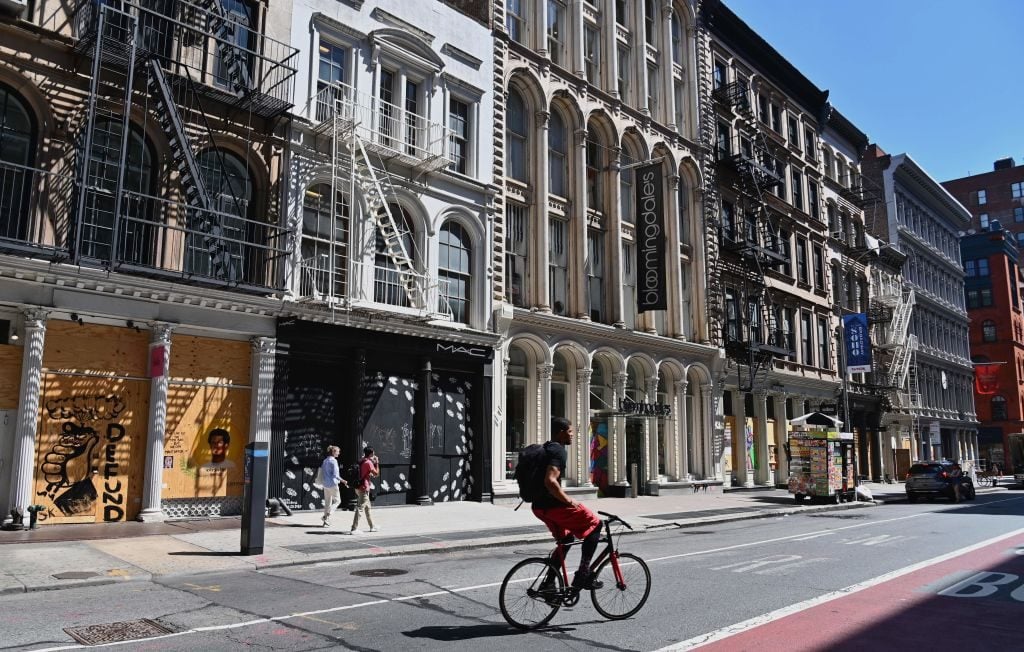
Cast-iron buildings in SoHo. (Photo by ANGELA WEISS/AFP via Getty Images)
Real estate overhead is one of the biggest burdens on commercial galleries and has contributed heavily to the stratification between large multinational dealers and small single-space galleries. How are your clients confronting this issue?
A lot of the galleries I deal with are established, and have been around for 10 to 30 years. They have artists selling at a point where a $20,000- or $30,000-a-month rent is still well within their means.
Given your work with galleries, it’s not really a surprise that you are quite an active collector, too. When did you start buying art?
I was always interested in objects. I collected sports cards, memorabilia, antiques, and then street art. I felt very overwhelmed by contemporary art. I didn’t have a lot of money 10 years ago, and buying something for $5,000 was a major, major, major decision and was a big purchase for me. The information out there was so vast, there are so many artists, so many galleries, and I wasn’t educated at that point. As I started working with galleries and helping them with their real estate needs, I started talking to dealers and started to understand a little bit more. It allowed me to hone in on my own taste, and that’s when I started collecting. I gravitated towards was narrative painting by young artists dealing with psychology and the human experience. That’s the bulk of what I’m interested in.
Did you have any mentors early on?
I wouldn’t say I had mentors. I had people that were willing to have conversations with me, but it was me taking the initiative. I sat next to Thea Westreich-Wagner at an opening dinner. We talked and I think she appreciated my enthusiasm and that I was genuinely interested in collecting art because I loved it. She gave me some great advice and said, “If you ever come across an artist that’s changing the dialogue of the medium in which they work, that’s an artist that you should pay attention to.” I just remember thinking about that again and again.
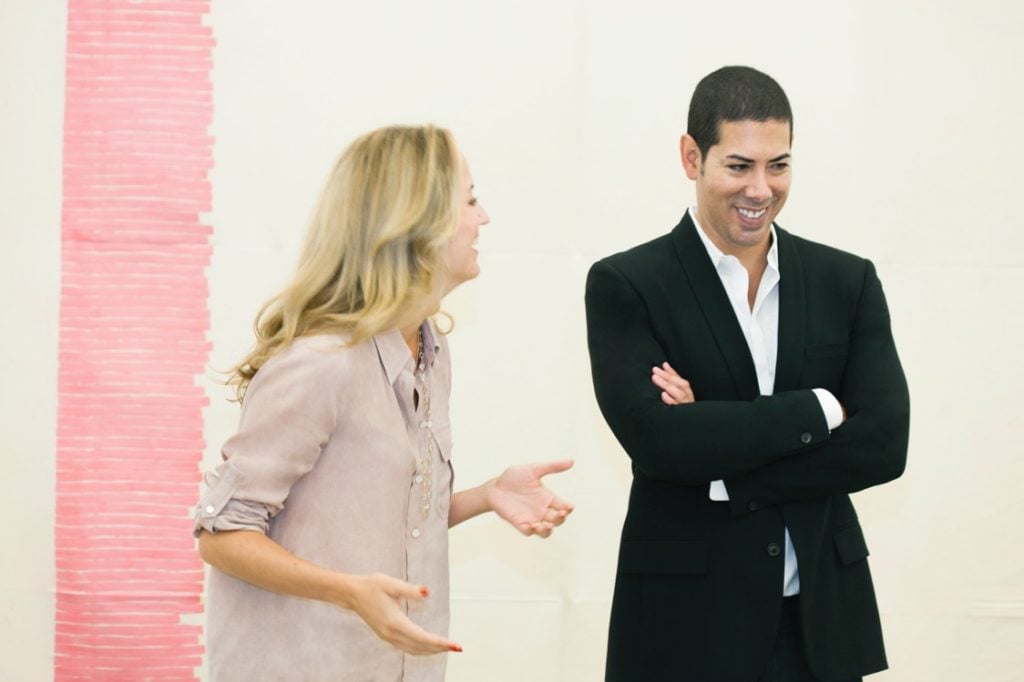
Casey Kaplan with Loring Randolph, left. Photo courtesy of Loring Randolph.
Over the course of every collector’s life there comes a point where they have to let go of a work or resell a work. Has this happened to you?
Yes, it’s happened. I have a pretty substantial collection at this point, and haven’t sold many works over the course of eight to 10 years, but every once in a while, you can sell a work that funds several other art purchases. And every time I do sell a work, it’s only to keep buying more art. I haven’t sold a work at public auction before, but yes, I have a small number of paintings over the years privately.
I’ve definitely purchased works from dealers that I’ve worked with numerous times. I wouldn’t say I force it, but I like the programs of a lot of the dealers that I rep, and that I have helped find spaces for. I bought several works from Max Marshall of Deli Gallery, Nicelle Beauchene, Isaac Lyles [of Lyles and King]. I’ve also bought work from Karma, James Cohan, Bortolami, and P.P.O.W.
But many of my clients are at an echelon where I’m not playing ball. A lot of the works are north of $25,000 and $50,000, and I’d much rather buy a work by a young artist for $5,000 to $10,000. Often that’s just not available at a lot of the galleries I work with because their programs are just too evolved.
I don’t have a trust fund, and I don’t have the ability to just keep buying forever. Thankfully I’ve found success in real estate, but when I first started working and living in New York City as a first-year broker, I made $52,000 and had no savings. Paying rent, trying to eat, and go on dates with that type of income is not very easy.
Earlier this year you moved out of New York to the Hudson Valley. Why did you make the move?
I was a proud New York City resident for 19 years, but I felt like I needed a change. I work in a very fast-paced business. At any given time, I’m probably working on 10-plus space requirements. It’s mentally daunting. I felt like I needed to come home to a place that felt a little more peaceful. And now I have more wall space, which is great because I have lots of paintings to hang and it’s exciting.
You’re starting a new residency. Can you explain the program?
The residency is called Wolf Hill and it’s in a house built in 1883 by a well-known doctor named Dr. Max Wolf. It was originally part of a 35-acre compound that has since been subdivided. Part of the remaining historical elements of the property include a sculpture garden with decrepit old, funky, weird sculptures, including Little Red Riding Hood and the Big Bad Wolf in the backyard.
I’ve been lucky to help a lot of young artists. I’ve helped artists get solo shows, or be placed in group shows, and I have a great network of young collectors that are interested in who I’m looking at. So the next progression of that is being able to offer young artists a place to live and work for free, and to help place their artworks with other great young collectors and introducing them to dealers.
Artists create a small body of work, then we celebrate with an exhibition at the house and have a little dinner party. And because the residency is a nonprofit, 50 percent of every sale will go directly to the artist. The other 50 percent will go to a charitable organization of the artist’s choosing. The idea was to allow them to benefit a cause they believe in.
The first participant is an Ecuadorian artist named Santiago Galeas who just graduated from the New York Academy of Art. I did a studio visit with Santiago a couple months ago, and I fell in love with one of his paintings and ended up purchasing it. He’s a lovely guy. He is exactly the type of person that we were hoping to provide exposure for.
